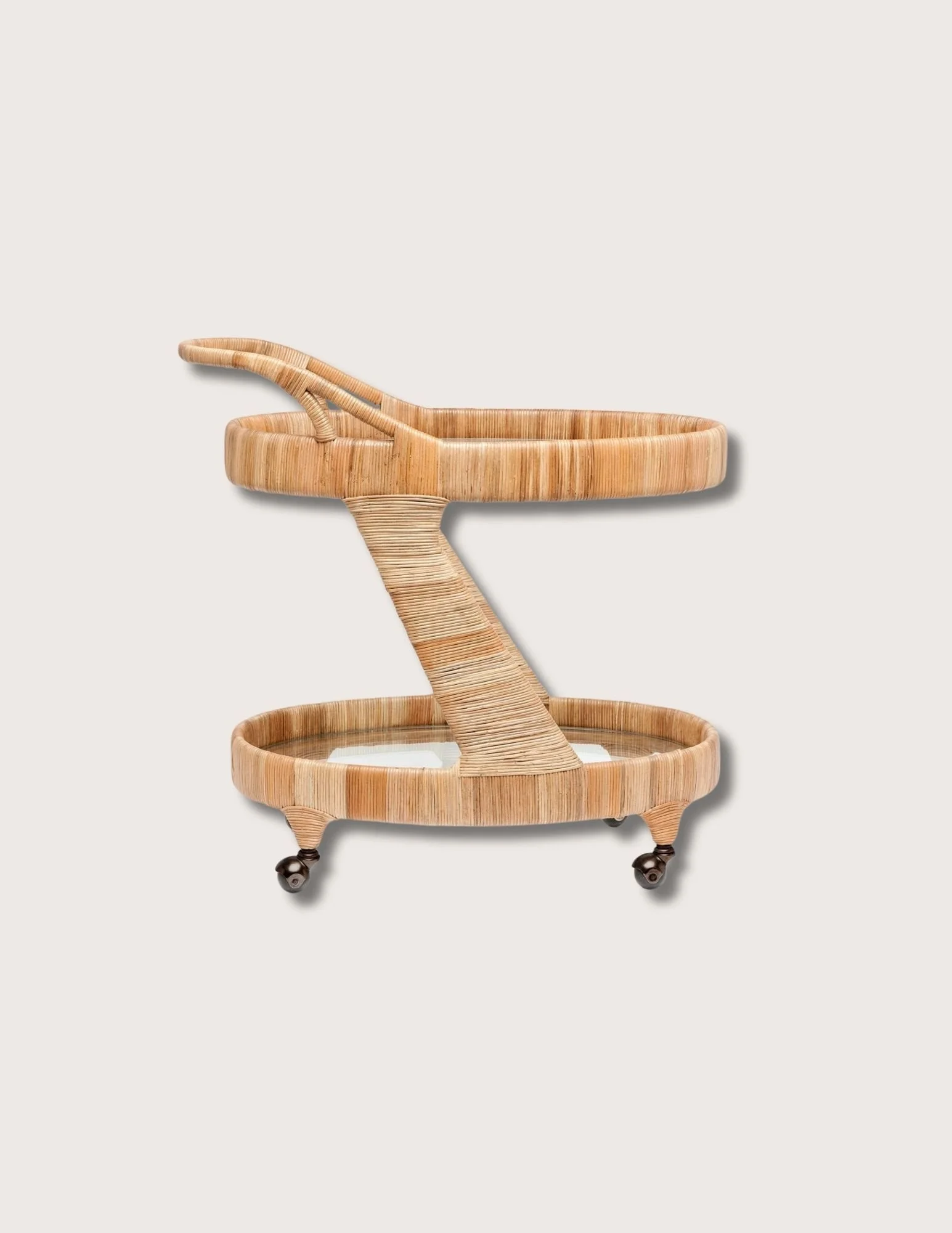 Image 1 of 2
Image 1 of 2

 Image 2 of 2
Image 2 of 2



Zambia Bar Cart
Details
The Zambia Bar Cart features a midcentury modern design with a wrapped rattan exterior. Boasting two glass shelves, there is ample room for beverages and accoutrements, including glassware, an ice bucket, shakers and stirrers for that perfect cocktail. Featuring four brass wheels that allow this cart to move with ease, the Zambia Bar Cart is functional and stylish with a whole lot of class.
Editors' Note
This piece is named for the nation of Zambia, one of many locales in West and Central Africa that are home to the Calamus deërratus species of rattan plant. One of the most populous of Africa's several rattan species the C. deërratus plant ranges from Zambia all the way to Senegal, Angola, Sudan and Uganda. Preferring swampland and forest environments, it is rarely found in areas that experience large quantities of annual rainfall. Zambia itself has been inhabited since ancient times, first by the Khoisan and Batwa peoples and later, by the Bantu who arrived in waves, the first occurring during the first millennium AD. And the second in the early 19th century as a result of the Mfecane ("crushing," or "dispersal") period of wars in South Africa, initiated by Shaka Zulu. These wars resulted in the migration of the Ngoni people to the area under their first king, Zwangendaba. Like so many contemporary names given to African ethnic groups, "Bantu" is a linguistic categorization of non-native origin. Coined by 19th century German linguist Wilhelm Bleek, who combined the words "ba" and "ntu," which together roughly translate to "humanity," or "mankind," the term encompasses as many as 500 distinct ethnicities. Upon arriving in what is now Zambia, the Bantu brought with them the arts of farming and animal husbandry as well as ironsmithing. The Khosian and Batwa inhabitants either married into Bantu groups or departed for other lands. Between the 15th and 18th centuries a series of kingdoms emerged throughout Zambia such as the Luba-Lunda States, the Mutapa Empire and the Maravi Confederacy, each of which contested Portuguese expansion in the area, dealing the Europeans several telling defeats. Though the balance of power waxed and waned between African and Portuguese groups for some time, Zambia, like much of Africa, did not come under direct colonial control until the late 19th century when the British South Africa Company (BSAC) began acquiring rights to locate and exploit mineral deposits in the region on behalf of the British government. Led by Cecil Rhodes, the BSAC carved out the territories of Northern and Southern Rhodesia (modern day Zambia and Zimbabwe, respectively), an area roughly 1/4 the size of the contiguous United States, through a combination of force and deception before turning over political control to the British Colonial Office in 1924. By 1964, Zambia was free of British control, reducing its time under direct colonial administration to only 40 years. Yet as with all former colonies, the repercussions of that time and the atrocities committed by the invading European colonizers continue to be felt to this day.
Details
The Zambia Bar Cart features a midcentury modern design with a wrapped rattan exterior. Boasting two glass shelves, there is ample room for beverages and accoutrements, including glassware, an ice bucket, shakers and stirrers for that perfect cocktail. Featuring four brass wheels that allow this cart to move with ease, the Zambia Bar Cart is functional and stylish with a whole lot of class.
Editors' Note
This piece is named for the nation of Zambia, one of many locales in West and Central Africa that are home to the Calamus deërratus species of rattan plant. One of the most populous of Africa's several rattan species the C. deërratus plant ranges from Zambia all the way to Senegal, Angola, Sudan and Uganda. Preferring swampland and forest environments, it is rarely found in areas that experience large quantities of annual rainfall. Zambia itself has been inhabited since ancient times, first by the Khoisan and Batwa peoples and later, by the Bantu who arrived in waves, the first occurring during the first millennium AD. And the second in the early 19th century as a result of the Mfecane ("crushing," or "dispersal") period of wars in South Africa, initiated by Shaka Zulu. These wars resulted in the migration of the Ngoni people to the area under their first king, Zwangendaba. Like so many contemporary names given to African ethnic groups, "Bantu" is a linguistic categorization of non-native origin. Coined by 19th century German linguist Wilhelm Bleek, who combined the words "ba" and "ntu," which together roughly translate to "humanity," or "mankind," the term encompasses as many as 500 distinct ethnicities. Upon arriving in what is now Zambia, the Bantu brought with them the arts of farming and animal husbandry as well as ironsmithing. The Khosian and Batwa inhabitants either married into Bantu groups or departed for other lands. Between the 15th and 18th centuries a series of kingdoms emerged throughout Zambia such as the Luba-Lunda States, the Mutapa Empire and the Maravi Confederacy, each of which contested Portuguese expansion in the area, dealing the Europeans several telling defeats. Though the balance of power waxed and waned between African and Portuguese groups for some time, Zambia, like much of Africa, did not come under direct colonial control until the late 19th century when the British South Africa Company (BSAC) began acquiring rights to locate and exploit mineral deposits in the region on behalf of the British government. Led by Cecil Rhodes, the BSAC carved out the territories of Northern and Southern Rhodesia (modern day Zambia and Zimbabwe, respectively), an area roughly 1/4 the size of the contiguous United States, through a combination of force and deception before turning over political control to the British Colonial Office in 1924. By 1964, Zambia was free of British control, reducing its time under direct colonial administration to only 40 years. Yet as with all former colonies, the repercussions of that time and the atrocities committed by the invading European colonizers continue to be felt to this day.

Additional Details
Rattan Bar Cart
Material: Rattan
Size: 32"L x 18"W x 31"H
Weight: 44 lbs
Imported
Made to order
Ships to the continental US in 3-4 weeks
Care Instructions: Wipe up spills immediately to avoid warping or staining. Blot with a clean, damp cloth. Remove small surface debris with a soft brush. Avoid harsh chemicals or abrasive cleaners.














